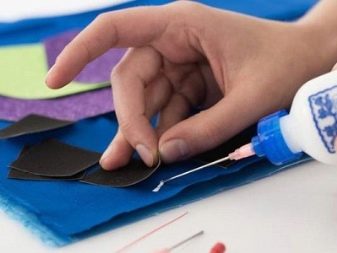What are fabric adhesives and how to use them?

In working with fabric, many craftswomen use not only needles, but also glue. Adhesives today are available in a fairly large assortment, and in many cases they are much more effective than conventional sewing.
High-quality glue options allow you to hold the fabric together so that the clothes are worn for many years later, even in conditions of active use.
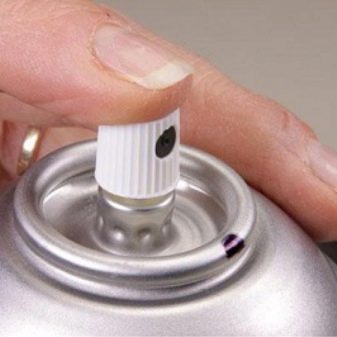
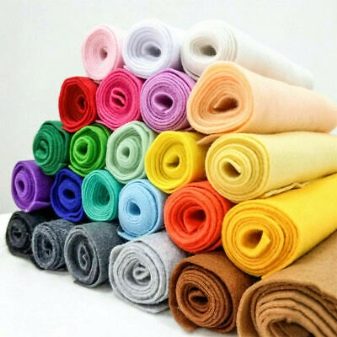
Peculiarities
Fabric adhesive allows you to replace the needle and thread. This method of working with fabric has two undeniable advantages: it is easier to sew on and much faster. In addition, the use of glue allows you to avoid such mistakes as the appearance of holes, puffs. The substance can be used both for gluing two elements of fabric, and for attaching an element to clothing.
The use of glue is advisable in the following cases.
- Restoration of clothes. Sometimes it happens that an ugly stain or hole forms on the clothes. Instead of sewing decor onto this area, you can simply glue it on.
- Finishing of edges and seams. Here, glue can replace fabric sweeping. The glued materials will retain their original shape well. Specialized clothing, for example, diving suits, is also treated with glue. In some cases, craftswomen refuse to sew seams altogether in favor of glue.
- Decor creation. If you want to decorate a thing with beads or rhinestones, then the easiest way will be to put them on glue, especially since some decorative elements do not have holes for the thread at all. It is also more convenient to attach applications with the help of glue.
- Making accessories. If you are fond of creating bracelets, hair ties, fabric necklaces, then it will be quite difficult to do without glue.

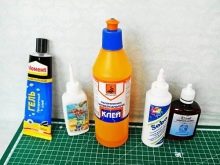
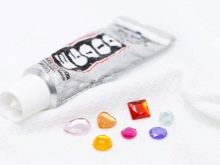
Views
The main requirement for the adhesive is moisture resistance, because any fabric product will sooner or later have to be washed. The following types of formulations meet these requirements.
Rubber based
Rubber is a resin obtained from special plants. It is completely natural and has been used for gluing objects for many decades in a row. Such textile glue is completely waterproof, then the thing can be washed an unlimited number of times. The glue is liquid, it does not freeze immediately, which is very good if you suddenly make a mistake and need to fix it.
The rubber glue hardens for a couple of hours, during which time the fabric should not be touched. For better adhesion of textile elements, you can put a load on top, for example, several books.
Basically, adhesives of the rubber group are used for fabrics with a high density. It can be jacquard, denim, dense satin.
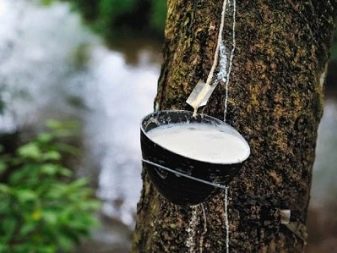

Hot glue
Such a composition is very convenient for processing. It can be colored or transparent, so when working with fabric, you will need to choose the right shade. The fabric glued with such a composition holds very securely, the treated area does not crack or crumble. With the correct selection of shades, the work with textiles is carried out without traces, so you should not worry about an accidentally falling drop. There are two options for hot melt glue. The first is presented as a dry powder form. Before work, it will need to be dissolved in heated water. The second subspecies are solid silicone rods that are inserted into a heat gun. When the structure heats up, the rod will begin to melt, releasing a thick and viscous mass.
This mass hardens quickly, so work should be done carefully and accurately. A glue gun can also be used to fasten fabrics together, but much more often it is used to plant beads and rhinestones on textiles.
It is worth noting that such high temperatures can damage the synthetic material, so it is best to test on an inconspicuous area before use.
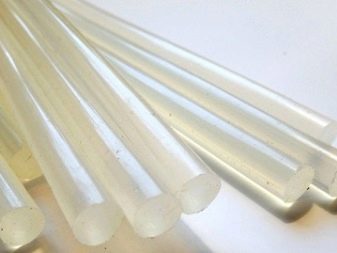
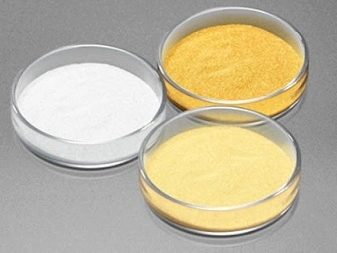
Synthetic
Compositions based on rubber may seem expensive to some, and in some cases it is impractical to purchase a thermal gun, especially when it comes to one-time processing. In such a situation, you can turn to synthetic formulations that are easy to use and often inexpensive.
- Acrylic. This type of glue as a whole is not intended for fabrics, its field of application is construction. And yet, among needlewomen, it has gained immense popularity due to the fact that it glues any fabric and is absolutely safe. Acrylics can be in powder form or already diluted. They fit exactly on any surface. But the disadvantages of such glue are decent. The first minus is yellow traces, so it is better not to use acrylic on very light materials. The second drawback is the need to purchase a special lamp that will allow the composition to harden.
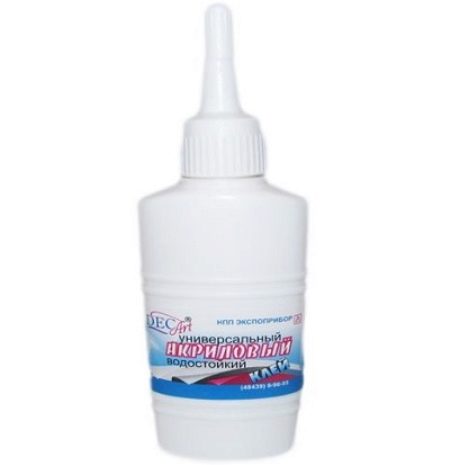
- Polyurethane. A similar composition is often used when repairing clothes. It is so reliable that it allows you to attach not only an air bead to things, but also a rather weighty shell. It takes a little more than a quarter of an hour for the polyurethane mixture to harden. The glue is waterproof, does not react to temperature changes. However, it has a very unpleasant odor.

- Silicone. This glue is also called polymer. It is completely transparent, after drying it becomes waterproof. Dries quickly, has a faint odor that disappears after the composition hardens.
Silicone glue can be used on all types of fabric.
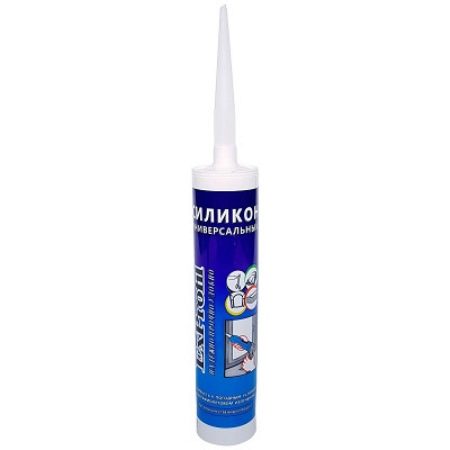
- PVA. Both adults and children know this glue. It is mainly used for working with paper crafts, but sometimes it is also used for fabrics. It is important to consider that PVA is not a waterproof compound. Therefore, it is recommended to take it exclusively for textile crafts, which will rarely be erased.
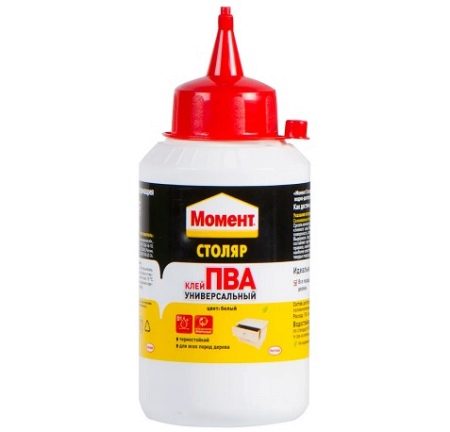
Other
There are several other fabric adhesives.
- Perchlorovinyl. Such glue glues textiles together quite well, it is often used when repairing fabric shoes, as well as in auto repair shops when repairing interior trim. The main disadvantage of this composition is its low elasticity. If the glued fabric is stretched, cracks can develop.
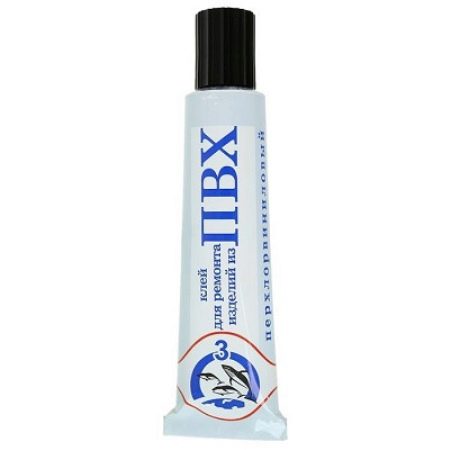
- Liquid thread. A similar glue is used in order to attach any decor to the material. It is very easy to apply liquid thread, it does not leave traces, it dries even without using a load. Suitable for light and difficult types of textiles.
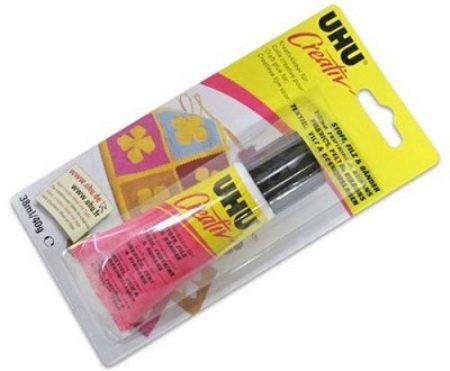
- Adhesive tape. At home, this is a common option. Mainly used for gluing seams, sealing them. The adhesive tape looks like a roll. The necessary part is cut off with scissors, placed between the fabric layers, covered with gauze and a couple of times carried out on top with an iron. When the mixture cools down, it will reliably glue the matter together.

- Spray can. The glue in the spray can is very easy to use. Spray is easy to spray, it is applied thinly, does not spray around. Aerosol composition is intended for temporary fixation, it is often used by craftswomen when sewing, holding parts of the patterns in place.
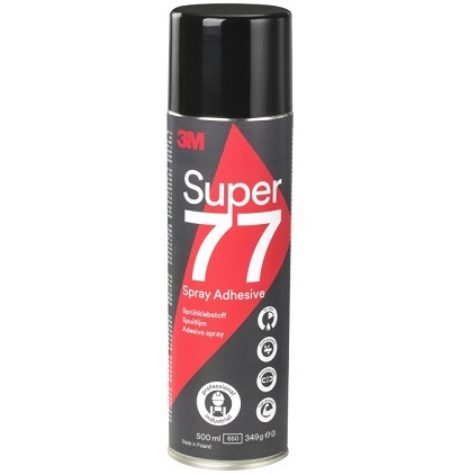
- Glue stick. This option is one of the varieties of PVA. Use it on things that are not intended for subsequent washing.
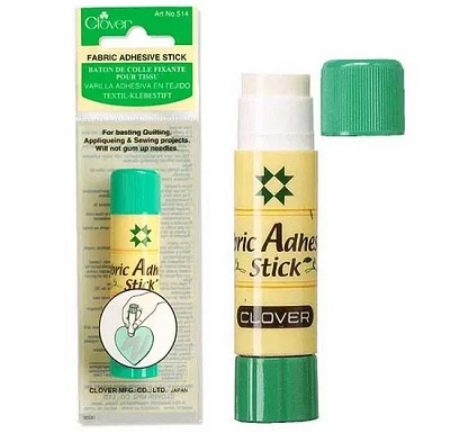
Top manufacturers
There are many manufacturers of adhesives for fabrics today. Let's get acquainted with those whose products have the most positive reviews.
- Javana. Compositions from this brand have different shades and a light metallic luster. The glue is liquid, easily and evenly applied, suitable for even the most difficult and delicate fabrics to work with. The result is to be fixed with an iron.

- Decola. The glue of this manufacturer is thick, its consumption is uneconomical, but the result will exceed all expectations. Basically, the company produces white glue options.
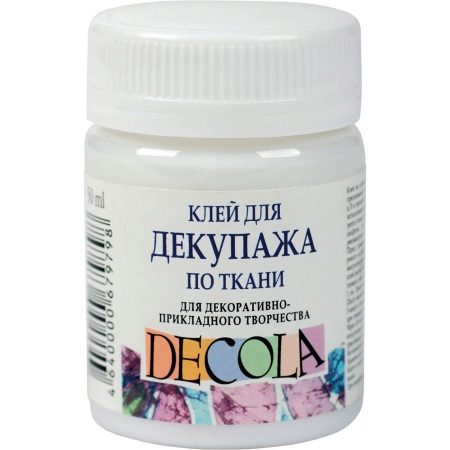
- Mod Podge Fabric. A good glue with a thick consistency, which not only glues the fabric, but also provides it with additional density. However, it hardens for a very long time, so the processed item can be washed only after 72 hours.
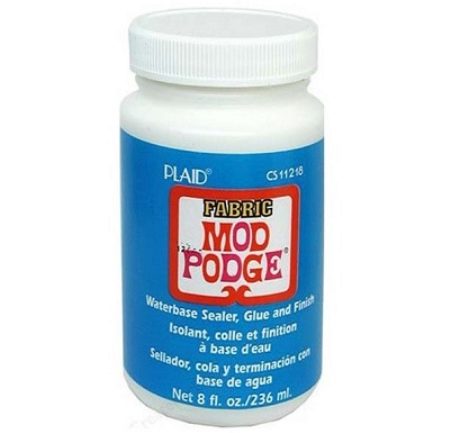
- Gutermann. Compositions from the company are intended for gluing different types of fabrics, including dense ones. Working with glue is very easy: if an accidental drop falls somewhere, you can simply wipe it off with a damp cloth.
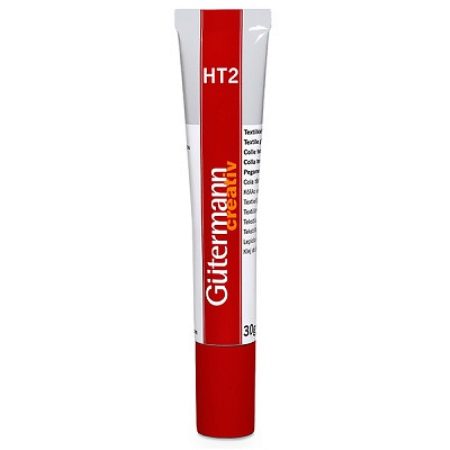
- 3M. One of the best options for glue in spray cans. Waterproof, able to withstand heat and frost well, leaves no residue.
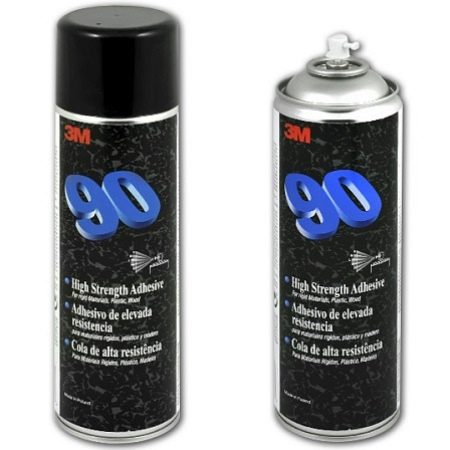
Selection Tips
Adhesive for textiles should be chosen carefully, because some formulations may not be suitable for certain types of fabrics. You should immediately pay attention to the following points.
- Versatility. If you don't know which type of glue is right for your job, it is worth taking the universal option that glue everything.
- Water resistance. Most of the things in any case are washed, ironed. If you plan to work with clothes, the glue must be resistant to moisture as well as heat.
- Setting time. This is also a very important parameter. When working with a composition for the first time, it is better to take one that freezes for a long time. This way you can quickly correct possible errors.
- Elasticity. Compounds that form an inelastic film after drying should be discarded immediately in the case of clothing. The slightest mechanical impact - and the outfit will disperse at the seams.



Now it's worth taking a closer look at what types of glue to buy for certain materials.
- If the thing is not intended for washing (for example, you are making a doll dress), then you can take the simplest PVA in liquid or pencil form. In addition, it will be convenient to use liquid thread for the manufacture of such products. PVA is also often used for decoupage, because it is very easy to wipe it off in case of an error.
- For gluing dense materials, it is recommended to use a rubber compound. Liquid thread, silicone, acrylic types of glue are also suitable.
- If you need to quickly glue some decor to the fabric, and this is not the first time you are doing this, then you can easily choose options such as "Moment" or "Second". They will immediately fix the product on the textile.
- To connect fabrics to each other, experts recommend taking dry powder mixtures. They quickly heat up and melt from the iron, holding the parts together securely.
- A good option for dense and natural fabrics, as well as for attaching decor, is a liquid silicone heat gun. But for synthetic materials, only cold exposure is permissible.
- For membrane types of fabrics, it is worth choosing silicone or polyurethane glue samples. The same applies to banner options, although powders are also acceptable here.

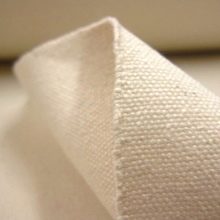

The nuances of working with glue
Each glue has its own nuances of use. Usually, complete information on the use is on the packaging with the product. Let's take a look at some general instructions.
- The fabric must be cleaned before use. The garment is washed, stains removed, dried completely and ironed. If the fabric is not intended for washing, wipe it with a cotton pad dipped in an alcohol solution and wait until it is completely dry.
- Most types of adhesives are applied directly to the processing site. You need to act carefully, trying to prevent drops from leaving the work area. To do this, you can select an area using unnecessary textiles or cardboard.
- After applying the glue, press down on the fabric with your fingers. Or, if this is a product, press it against the textiles for several minutes. Try not to stick your fingers along with the decor.
- If you do drop a drop of glue, and it has already dried out, do not be too upset. Most of the compounds can be removed with vinegar, gasoline, acetone, alcohol.
It is only important to pre-test the product so that it does not spoil the fabric.
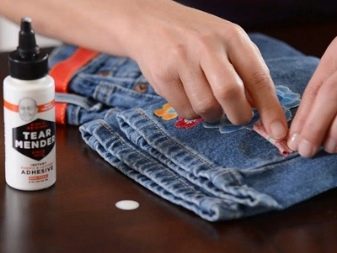
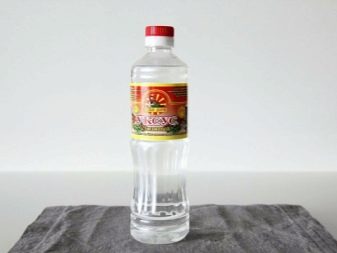
Now let's take a quick look at how to work with the most common product variations.
- The rubber compounds are applied to the processing site from both sides, pressed firmly, then left to dry. The use of the press will be useful.
- The thermo-gun gives out a mass, which grasps rather quickly. You need to work carefully. After warming up the device from the mains, its nose is directed to the area to be treated. Do not put your fingers there, as the mass is very hot.
- Vinyl perchloric acid, polyurethane, silicone products are similar in use to rubber. However, it is not necessary to spread both sides at once, but some one. When the first dries up, the glue is applied to the second part and only then is it fastened.
- Waterproof compounds for dense materials are applied only to a degreased surface. Degreasing is most often done with acetone.
- If you need to glue a bead, rhinestones or any other small jewelry on the clothes, then first a tiny drop of glue is applied to the material, and then the decor is placed directly on it. It is better to take it with a special stick or tweezers.

